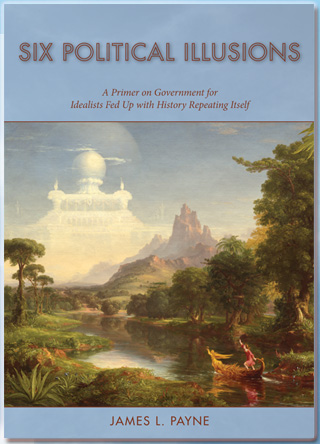
Read Excerpts
(Page numbers refer to Six Political Illusions; A Primer on Government for Idealists Fed Up with History Repeating Itself, Lytton, 2010)
- “All government spending programs take funds from worthy causes and needy people.”
Answers a or b (agree) score 1. Answers c or d indicate that the philanthropic illusion is at work in the subject’s thinking (Chapter 1, especially pp. 12-19).
- “The use of physical force is a healthy foundation for social reform.”
This statement helps set the context for statement 3 (Everyone is expected to disagree with statement 2).
- “The modern welfare state relies on government’s use of physical force.”
Answers a or b (agree) score 1. The answers c or d indicate that the voluntary illusion is at work in the subject’s thinking (Chapter 2, especially pp, 31-36, 40-41).
- “The waste in government spending programs is typically around. . .”
Answer d (“over 100%”) score 1. Answer c (50-100%) score 0.5 All other answers indicate the presence of the illusion of the frictionless state (Ch 3):
No one has attempted a comprehensive calculation of waste in spending programs (see p. 58); those who have explicitly tried to estimate this figure come up with numbers over 100% because they notice costs that most of the world overlooks (such as the disincentive cost of taxation, disincentive cost of disbursement, etc (see pp 50-61). Low estimates reflect the unexamined presence of the illusion of the frictionless state.
Answer e, (Don’t know) also indicates the presence of the illusion of the frictionless state (assuming the respondent favors any government programs). It is irrational to favor any spending program without making an informed estimate of their overhead costs, because these costs could outweigh any benefit of the program.
- “Maybe spending more money on schools wouldn’t solve all their problems, but it’s bound to help at least a little to improve the quality of education.”
Answers c or d “disagree”: score 1. Agree answers indicate the materialistic illusion (Chapter 4, especially pp 69-71)
- “The officials in charge of any government program may be uninformed, irrational, shortsighted, lazy, irresponsible, or corrupt.”
Answer “agree”: score 1. The reluctance to accept this logically irrefutable statement (notice “may”) indicates an attachment to the watchful eye illusion (the belief that government officials tend to have superior wisdom, responsibility, etc) (Ch 5).
- “Even when government’s programs in education, environment, health, or welfare fail, we shouldn’t stop trying because government is how we solve our collective problems.”
Answers c or d “disagree” score:1. This statement contains the illusion of government preeminence (Ch 6, especially pp 108-110).




